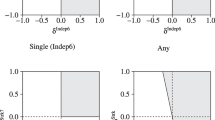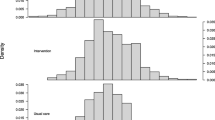Abstract
In the extant literature, hierarchical models typically assume a flexible distribution for the random-effects. The random-effects approach has been used in the inferential procedure of the generalized linear mixed models . In this paper, we propose a random intercept gamma mixed model to fit correlated asymmetric positive continuous outcomes. The generalized log-gamma (GLG) distribution is assumed as an alternative to the normality assumption for the random intercept. Numerical results demonstrate the impact on the maximum likelihood (ML) estimator when the random-effect distribution is misspecified. The extended inverted Dirichlet (EID) distribution is derived from the random intercept gamma-GLG model that leads to the EID regression model by supposing a particular parameter setting of the hierarchical model. Monte Carlo simulation studies are performed to evaluate the asymptotic behavior of the ML estimators from the proposed models. Analysis of diagnostic methods based on quantile residual and COVARATIO statistic are used to assess departures from the EID regression model and identify atypical subjects. Two applications with real data are presented to illustrate the proposed methodology.






Similar content being viewed by others
References
Abramowitz M, Stegun IA (1972) Handbook of mathematical functions. Dover, New York
Alonso A, Litière S, Molenberghs G (2008) A family of tests to detect misspecifications in the random-effects structure of generalized linear mixed models. Comput Stat Data Anal 52:4474–4486
Belsley DA, Kuh E, Welsch RE (1980) Regression diagnostics: identifying influential data and sources of collinearity. Wiley, New York
Booth JG, Casella G, Friedl H, Hobert JP (2003) Negative binomial loglinear mixed models. Stat Model 3:179–191
Bossio-Corrales L, Cuervo-Cepeda E (2019) A Bayesian approach to mixed gamma regression models. Rev Colomb Estat 42:81–99
Crowder MJ, Hand DJ (1990) Analysis of repeated measurements, 1st edn. Chapman and Hall, London
Dunn PK, Smyth GK (1996) Randomized quantile residuals. J Comput Graph Stat 3:236–244
Fabio L, Paula GA, Castro M (2012) A Poisson mixed model with nonormal random effect distribution. Comput Stat Data Anal 56:1499–1510
Lawless JF (2002) Statistical models and methods for lifetime data, 2nd edn. Wiley, New York
Leão J, Cysneiros F, Saulo H, Balakrishnan N (2016) Constrained test in linear models with multivariate power exponential distribution. Comput Stat 31:1569–1592
Litière S, Alonso A, Molenberghs G (2007) The impact of a misspecified random-effects distribution on the estimation and the performance of inferencial procedures in generalized linear mixed models. Stat Med 27:3125–3144
McCulloch CE, Neuhaus JM (2011) Misspecifying the shape of a random effects distribution: why getting it wrong may not matter. Stat Sci 3:388–402
McCulloch CE, Searle SR (2001) Hierarchical generalized linear models: a synthesis of generalized linear models, random effect models and structured dispersions. Biometrika 88:987–1006
Molenberghs G, Verbeke G (2006) Models for discrete longitudinal data, 1st edn. Springer, New York
Molenberghs G, Verbeke G, Demètrio CGB (2007) An extended random-effects approach to modeling repeated, overdispersed count data. Lifetime Data Anal 13:513–531
Molenberghs G, Verbeke G, Demètrio CGB, Vieira AMC (2010) A family of generalized linear models for repeated measures with normal and conjugate random effects. Stat Sci 25:325–347
Ng KW, Tian G-L, Tang M-L (2011) Dirichlet and related distributions: theory, methods and applications, 1st edn. Wiley, London
Prentice R (1974) A log gamma model and its maximum likelihood estimation. Biometrika 61:539–544
R Core Team (2021) R: a language and environment for statistical computing. R Foundation for Statistical Computing, Vienna
Vaida F, Blanchard S (2005) Conditional Akaike information for mixed-effects models. Biometrika 92:351–370
Zhang P, Song PX-K, Qu A, Greene T (2008) Efficient estimation for patient-specific rates of disease progression using nonnormal linear mixed models. Biometrics 64:29–38
Acknowledgements
We gratefully acknowledge the financial support from CNPq-Brazil. We also thank two anonymous referees for constructive comments and suggestions.
Author information
Authors and Affiliations
Corresponding author
Ethics declarations
Conflict of interest
The authors declare that they have no conflict of interest.
Additional information
Publisher's Note
Springer Nature remains neutral with regard to jurisdictional claims in published maps and institutional affiliations.
Supplementary Information
Below is the link to the electronic supplementary material.
Appendices
Appendix
EIB distribution
Proposition 1
If \(z=(\phi \mu /\kappa )y\), then the random variable z follows an inverted-beta distribution with parameters \(\phi \) and \(\kappa \). In addition, let t be a random variable which follows a beta distribution, \(t \sim beta(\phi ,\kappa )\). Then, \(v=t/(1-t)\) has an inverted-beta distributions and \((\phi \mu /\kappa )v\) follows a distribution as in (6).
Proof
The proof is direct. \(\square \)
Proposition 2
For \(\kappa >1\) and \(\kappa >2\), the mean and variance of \(y \sim EIB(\mu , \phi , \kappa )\) are
-
(i)
\(\mathrm{E}(y)=\mu ^{-1}\kappa \varGamma (\kappa -1)/\varGamma (\kappa )\). If \(\kappa \) is a positive integer, it follows that \(\mathrm{E}(y)=\mu ^{-1}\kappa /(\kappa - 1)\).
-
(ii)
\(\mathrm{Var}(y)= \phi ^{-1}\mu ^{-2}\kappa ^2\left[ (\phi + 1)\left( \varGamma (\kappa - 2)/\varGamma (\kappa )\right) - \varGamma ^{2}(\kappa - 1)/\varGamma ^2(\kappa )\right] \). If \(\kappa \) is a positive integer, iy follows that \(\mathrm{Var}(y)=\phi ^{-1}\mu ^{-2}\kappa ^{2}(\phi +\kappa -1)/(\kappa -1)^2(\kappa -2),\)
where \(\varGamma (\cdot )\) is the gamma function.
Observing that when \(\kappa \rightarrow \infty \) the mean of E\((y)=\mu ^{-1}\) and the variance increases.
Proof
The integral in (9) is the inverted-beta pdf with parameters \(\phi +1\) and \(\kappa -1,\) if \(\kappa >1.\) Simplifying (9) leads to the Preposition 2(i). Similarly, we obtain E\((y^2)=\mu ^{-2}\phi ^{-2}\kappa ^2\frac{B(\phi +2, \kappa -2)}{B(\phi ,\kappa )}.\) Thus, the Preposition 2(ii) follows from the expression Var\((y) = \mathrm{E}(y^{2}) - (\mathrm{E}(y))^{2}\). \(\square \)
Rights and permissions
About this article
Cite this article
Fabio, L.C., Cysneiros, F.J.A., Paula, G.A. et al. Hierarchical and multivariate regression models to fit correlated asymmetric positive continuous outcomes. Comput Stat 37, 1435–1459 (2022). https://doi.org/10.1007/s00180-021-01163-7
Received:
Accepted:
Published:
Issue Date:
DOI: https://doi.org/10.1007/s00180-021-01163-7




